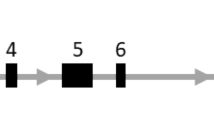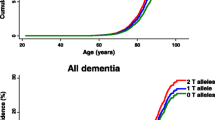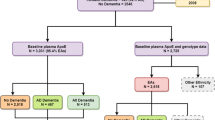Abstract
Alzheimer’s disease (AD) is the most common type of dementia, with a prevalence that is rising every year. AD is associated with type 2 diabetes mellitus (T2DM) and insulin resistance, and is therefore sometimes called “type 3 diabetes mellitus”. The aim of this study was to examine whether the variants of some candidate genes involved in the development of AD, namely BIN1 (rs744373), CLU (rs11136000), CR1 (rs3818361), and PICALM (rs3851179), are related to several disorders of glucose metabolism—gestational diabetes (GDM), T2DM and impaired glucose tolerance (IGT). Our study included 550 women with former GDM and 717 control women, 392 patients with T2DM and 180 non-diabetic controls, and 117 patients with IGT and 630 controls with normal glucose tolerance. Genotyping analysis was performed using specially-designed TaqMan assays. No significant associations of the genetic variants rs744373 in BIN1, rs11136000 in CLU, or rs3818361 in CR1 were found with GDM, T2DM or IGT, but rs3851179 in PICALM was associated with an increased risk of GDM. The frequency of the AD risk-associated C allele was significantly higher in the GDM group compared to controls: OR 1.21; 95% CI (1.03–1.44). This finding was not apparent in T2DM and IGT; conversely, the C allele of the PICALM SNP was protective for IGT: OR 0.67; 95% CI (0.51–0.89). This study demonstrates an association between PICALM rs3851179 and GDM as well as IGT. However, elucidation of the possible role of this gene in the pathogenesis of GDM requires further independent studies.
Similar content being viewed by others
References
Prince M, Albanese E, Guerchet M, Prina M (2014) World Alzheimer report 2014. Alzheimer’s Disease International, London, England
Pimplikar SW (2009) Reassessing the amyloid cascade hypothesis of Alzheimer’s disease. Int J Biochem Cell Biol 41(6):1261–1268
Ballatore C, Lee VM, Trojanowski JQ (2007) Tau-mediated neurodegeneration in Alzheimer’s disease and related disorders. Nat Rev Neurosci 8(9):663–672
Steen E, Terry BM, Rivera EJ, Cannon JL, Neely TR, Tavares R, Xu XJ, Wands JR, de la Monte SM (2005) Impaired insulin and insulin-like growth factor expression and signaling mechanisms in Alzheimer’s disease-is type 3 diabetes? J Alzheimers Dis 7(1):63–80
de la Monte SM, Wands JR (2005) Review of insulin and insulin-like growth factor expression, signaling, and malfunction in the central nervous system: relevance to Alzheimer’s disease. J Alzheimers Dis 7(1):45–61
Rivera EJ, Goldin A, Fulmer N, Tavares R, Wands JR, de la Monte SM (2005) Insulin and insulin-like growth factor expression and function deteriorate with progression of Alzheimer’s disease: link to brain reductions in acetylcholine. J Alzheimers Dis 8(3):247–268
Steen E, Terry BM, Rivera EJ, Cannon JL, Neely TR, Tavares R, Xu XJ, Wands JR, de la Monte SM (2005) Impaired insulin and insulin-like growth factor expression and signaling mechanisms in Alzheimer’s disease—is the type 3 diabetes? J Alzheimers Dis 7(1):63–80
Waring SC, Rosenberg RN (2008) Genome-wide association studies in Alzheimer disease. Arch Neurol 65(3):329–334
Lambert JCh, Heath S, Even G et al (2009) Genome-wide association study identifies variants at CLU and CR1 associated with Alzheimer’s disease. Nat Genet 41(10):1094–1099
Seshadri S, Fitzpatrick AL, Ikram MA et al (2010) Genome-wide analysis of genetic loci associated with Alzheimer disease. JAMA 303(18):1832–1840
Kamboh MI, Demirci FY, Wang X et al (2012) Genome-wide association study of Alzheimer’s disease. Transl Psychiatry 2(5):e117
Vilatela MEA, López-López M, Yescas-Gómez P (2012) Genetics of Alzheimer’s disease. Arch Res Med 43(8):622–631
Harold D, Abraham R, Hollingworth P et al (2009) Genome-wide association study identifies variants at CLU and PICALM associated with Alzheimer’s disease. Nat Genet 41(10):1088–1093
Scotland PB, Heath JL, Conway AE, Porter NB, Armstrong MB, Walker JA, Klebig ML, Lavau CP, Wechsler DS (2012) The PICALM protein plays a key role in iron homeostasis and cell proliferation. PLoS ONE 7(8):e44252
Crespo AC, Silva B, Marques L, Marcelino E, Maruta C, Costa S, Timoteo A, Vilares A, Couto FS, Faustino P, Correira AP, Verdelho A, Porto G, Guerreiro M, Herrero A, Costa C, de Mendoca A, Costa L, Martins M (2014) Genetic and biochemical markers in patients with Alzheimer’s disease support a concentrated systemic iron homeostasis dysregulation. Neurobiol Aging 35(4):777–785
Bartzokis G, Tishler TA (2000) MRI evaluation of basal ganglia ferritin iron and neurotoxicity in Alzheimer’s and Hungtington’s disease. Cell Mol Biol 46(4):821–833
Amiri FN, Basirat Z, Omidvar S, Sharbatdaran M, Tilaki KH, Pouramir M (2013) Comparison of the serum iron, ferritin levels and total iron-binding capacity between pregnant women with and without gestational diabetes. J Nat Sci Biol Med 4(2):302–305
Khambalia AZ, Aimone A, Nagubandi P, Roberts CL, McElduff A, Morris JM, Powell KL, Tasevski V, Nassar N (2016) High maternal iron status, dietary iron intake and iron supplement use in pregnancy and risk of gestational diabetes mellitus: a prospective study and systematic review. Diabet Med 33(9):1211–1221
Yang A, Zhao J, Lu M, Gu Y, Zhu Y, Chen D, Fu J (2016) Expression of hepcidin and ferroportin in the placenta, and ferritin and transferrin receptor 1 levels in maternal and umbilical cord blood in pregnant women with and without gestational diabetes. Int J Environ Res Public 13(8):766
Mercer JL, Argus JP, Crabtree DM, Keenan MM, Wilks MQ, Chi JT, Bensinger SJ, Lavau CP, Wechsler DS (2015) Modulation of PICALM levels perturbs cellular cholesterol homeostasis. PLoS ONE 10(6):e0129776
McFall GP, Wiebe SA, Vergote D, Anstey KJ, Dixon RA (2015) Alzheimer’s genetic risk intensifies neurocognitive slowing associated with diabetes in non-demented older adults. Alzheimers Dement 1(4):395–402
Acknowledgements
Supported by the Ministry of Health, Czech Republic—conceptual development of a research organization (Institute of Endocrinology—EU, 00023761) and by IGA NT/13543-4 Ministry of Health, Czech Republic.
Author information
Authors and Affiliations
Corresponding author
Ethics declarations
Conflict of interest
There is no conflict of interest.
Rights and permissions
About this article
Cite this article
Vacínová, G., Vejražková, D., Lukášová, P. et al. Associations of polymorphisms in the candidate genes for Alzheimer’s disease BIN1, CLU, CR1 and PICALM with gestational diabetes and impaired glucose tolerance. Mol Biol Rep 44, 227–231 (2017). https://doi.org/10.1007/s11033-017-4100-9
Received:
Accepted:
Published:
Issue Date:
DOI: https://doi.org/10.1007/s11033-017-4100-9




